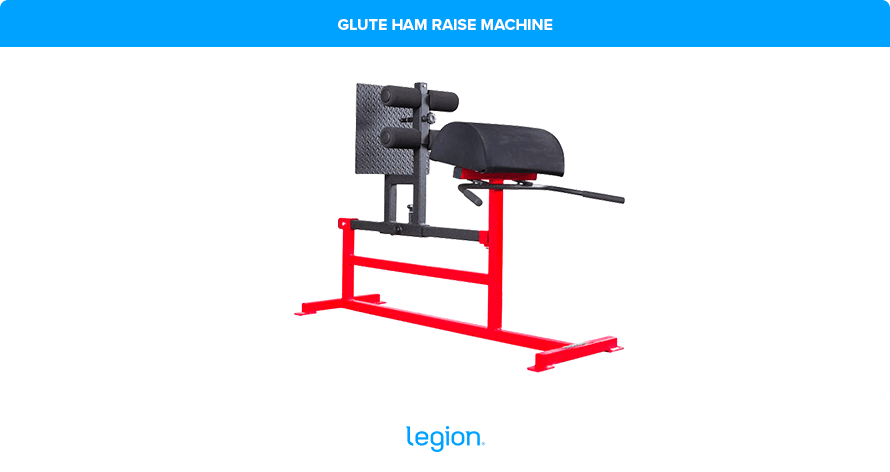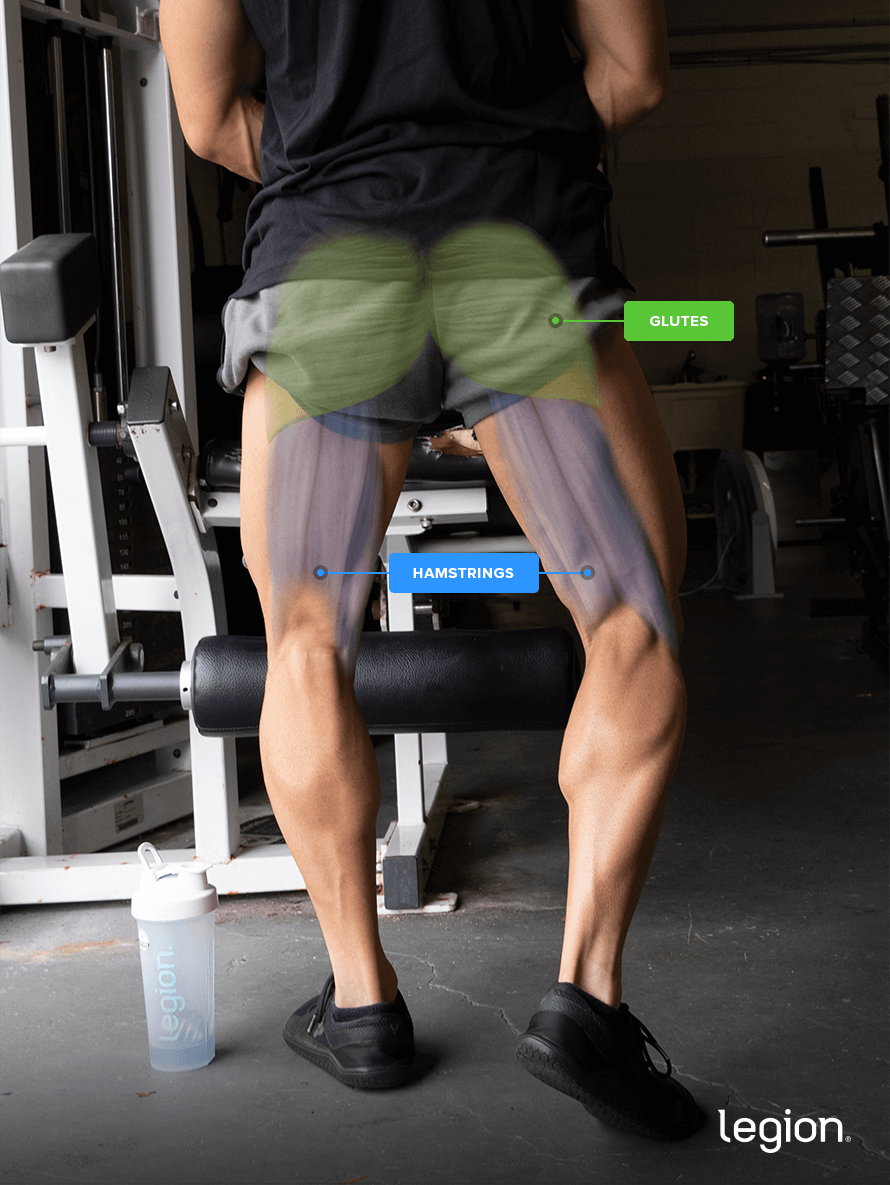The glute-ham raise is an outstanding lower-body exercise deserving of more attention.
It’s exceptionally effective for training the hamstrings and glutes without significantly contributing to overall fatigue, making it ideal for anyone looking to gain posterior chain muscle and strength.
It also doesn’t load your spine, so it’s a useful workaround for anyone with back issues or wanting to continue training their hamstrings and glutes when they’re already fried from deadlifting or squatting.
In this expert guide, you’ll learn what a glute-ham raise (and glute-ham raise machine) is, how to do glute-ham raises with proper form, the benefits of the exercise, which muscles it works, how to include it in your program, the best glute-ham raise alternatives and variations, and more.
Table of Contents
+
What Are Glute-Ham Raises?
The glute-ham raise, or “GHR” exercise, is a strength training exercise that primarily trains the glutes and hamstrings.
You perform it on a piece of equipment called a glute-ham raise machine, or “glute-ham developer” (GHD), which supports your thighs and anchors your feet, allowing you to lower your chest toward the floor by leaning forward and pull yourself back to the starting position using your hamstrings.
Glute-Ham Raise Machine
While you can perform glute-ham raise alternatives using a range of equipment, you need a glute-ham raise machine to do the GHR properly.
Here’s what a glute-ham raise machine looks like:

The benefit of using a glute-ham raise machine is that it provides the support and stability necessary to train through a full range of motion comfortably, boosting the safety and effectiveness of the exercise.
How to Do the Glute-Ham Raise
To learn how to do the glute-ham raise, split the exercise into three parts: set up, descend, and raise.
1. Set up
Climb onto the glute-ham developer, position the ankle pads against your lower shins and Achilles tendons to “lock” your feet in place, press your toes into the footplate hip-width apart, and rest your quads on the pad.
You’re in the correct position when your knees are slightly below the pad and a little lower than your ankles when viewed from the side.
Bend your knees and flex your glutes so that your body is upright and forms a straight line from your head to your knees, then cross your arms over your chest.
2. Descend
Keeping your back flat and glutes flexed, press your toes into the footplate and straighten your knees to lower your chest toward the floor by leaning forward. Continue lowering your torso until your upper body is parallel to the floor.
3. Raise
Lift your body back to the starting position by pulling with your hamstrings and flexing your knees. This mirrors what you did during the descent.
Here’s how it should look when you put it all together:
Benefits of the Glute-Ham Raise
1. It effectively trains the hamstrings.
Research shows that the glute-ham raise trains all parts of the hamstrings to a high degree and trains the lower back and calves to a lesser extent.
2. It allows you to train your hamstrings when your lower back is tired.
If you only train your glutes and hamstrings with compound exercises like the deadlift and Romanian deadlift, you’ll often have to stop training when your lower back is tired, even though your glutes and hammies could handle more.
The glute-ham raise helps in this scenario because it allows you to train your hamstrings and glutes when your back is tired, ensuring they get the stimulus they need to grow.
3. It’s ideal for people with lower back issues.
Unlike most exercises that train the posterior chain (the muscles on the back of your body), the glute-ham raise doesn’t load your spine, making it an excellent exercise for those with lower back issues.
Muscles Worked by the Glute-Ham Raise
The main muscles worked by the glute-ham raise are the glutes and hamstrings. It also trains your calves and lower back to a lesser degree.
Here’s how the main muscle groups worked by glute raises look on your body:

Sets and Reps for the Glute-Ham Raise
For people looking to gain muscle, 3 sets of 5-to-15 reps works well.
The glute raise is exceptionally challenging at first, so shooting for 3 sets of 5 reps is reasonable.
As you get stronger, aiming for closer to 15 reps per set will yield better results. And once you can easily perform sets of 15 reps, adding weight to the GHR exercise allows you to continue progressing.
To use the GHR to build strength specifically, work in a lower rep range, such as 4-to-6 or 6-to-8 reps per set. To ensure you stay within your chosen rep range and gain strength effectively, performing the exercise with a barbell on your back is usually necessary.
From an exercise order perspective, it’s best to do the GHR in your leg or lower-body workouts after you’ve completed your main compound exercises for the day.
The Best Glute-Ham Raise Alternatives and Variations
1. Romanian Deadlift
The Romanian deadlift is a top-tier posterior chain exercise because it allows you to lift heavy weights safely and progress regularly, making it ideal for gaining size and strength in all the muscles on the back of your body.
2. Good Morning
The good morning allows you to train your glutes and hamstrings with heavy weights and in a stretched position, which is beneficial for muscle growth.
3. Hip Thrust
The positioning of the barbell during hip thrusts forces your glutes and hamstrings to work hard throughout the entire range of motion, which is a unique benefit of this exercise. It’s also easy to progressively overload, so it’s an outstanding exercise for gaining muscle and strength.
4. Nordic Hamstring Curl
Research shows that the Nordic curl is a fantastic bodyweight hamstring exercise, which may also reduce your risk of suffering a hamstring injury.
5. Leg Curl
Unlike most hamstring exercises, the seated leg curl trains your hamstrings through a full range of motion and in a stretched position, which is highly effective for gaining hamstring size and strength.
6. Hyperextension
Research shows that the hyperextension is an excellent exercise for glute and hamstring development. To increase how much your glutes and hamstrings contribute to the exercise, position the pad a little below your hips, turn your feet out slightly, tuck your chin to your chest, and round your upper back, then extend your hips to lift your back.
7. Weighted Glute-Ham Raise
Adding weight to the glute-ham raise by placing a barbell on your back, holding a plate against your chest, or using a weighted vest increases the intensity of the exercise. This variation is perfect for those who have mastered the bodyweight glute-ham raise and are looking for a greater challenge.
8. Swiss Ball Leg Curl
The Swiss ball leg curl requires minimal equipment and space, making it an excellent glute-ham raise alternative if you don’t have access to a gym. While many think of it as a GHR alternative for beginners, the instability makes it a deceptively challenging exercise suitable for people of all experience levels.
Who Should Do Glute-Ham Raises?
The glute-ham raise is ideal for anyone aiming to build glute and hamstring muscle for several reasons:
- It allows you to isolate your glutes and hamstrings, which means you can train them with the volume they need to grow without other muscle groups becoming the limiting factor.
- It allows you to train these muscles through a different range of motion than other exercises, which likely enhances muscle growth.
- It gives you a break from heavy pulling and squatting, which can help keep training more engaging, fun, and productive.
- It’s easier on the joints than heavy squatting and deadlifting, which may reduce your risk of injury.
FAQ #1: Can you do a glute-ham raise without a GHR machine?
Not exactly, but you can perform exercises that have similar benefits, such as the Romanian deadlift, good morning, hip thrust, Nordic curl, leg curl, hyperextension, and Swiss ball leg curl.
Of these exercises, the Nordic curl is probably the most similar to the glute-ham raise and doesn’t require any specialist equipment.
FAQ #2: Are glute-ham raises worth it?
Yes, glute-ham raises are a very worthwhile exercise for anyone looking to strengthen their posterior chain, improve athletic performance, help prevent injuries, and build muscle.
FAQ #3: Why is the glute raise so hard?
Many beginners struggle with the glute-ham raise because it demands considerable strength and control from the glutes, hamstrings, and lower back, which are often weak in those new to strength training. If you’re also overweight, the GHR can be even more challenging because it requires you to lift your body weight.
You can overcome these difficulties by performing easier alternatives or variations to gradually build the necessary strength to perform the GHR comfortably.
FAQ #4: What is the difference between Nordic curls and glute-ham raises?
In the Nordic hamstring curl, your feet and knees are in line with each other (both on the floor), whereas in the glute-ham raise, the knee pad places your knees slightly below your feet. This means that the “lever arm” (in this case, your torso and thighs) is slightly longer in the Nordic curl, which is why the Nordic curl feels more challenging than the glute-ham raise.
Both exercises train the same muscles to a comparable degree, so you can do whichever you prefer or alternate between them every 8-to-10 weeks of training.
FAQ #5: Is the glute-ham raise bad for your knees?
The glute-ham raise isn’t bad for your knees when performed correctly. In fact, it can strengthen the muscles around the knees, providing better support and stability.
That said, some people experience knee pain when performing the glute-ham raise, most often because they place their knees too high on the pad, which can cause your knees to hyperextend at the bottom of each rep.
To avoid this, simply ensure your knees are in the correct position slightly below the knee pad when setting up the exercise.
Scientific References +
- McAllister, Matt J., et al. “Muscle Activation during Various Hamstring Exercises.” Journal of Strength and Conditioning Research, vol. 28, no. 6, June 2014, pp. 1573–1580, https://doi.org/10.1519/jsc.0000000000000302.
- Schellenberg, Florian, et al. “Towards Evidence Based Strength Training: A Comparison of Muscle Forces during Deadlifts, Goodmornings and Split Squats.” BMC Sports Science, Medicine and Rehabilitation, vol. 9, no. 1, 17 July 2017, https://doi.org/10.1186/s13102-017-0077-x.
- Ebben, William P. “Hamstring Activation during Lower Body Resistance Training Exercises.” International Journal of Sports Physiology and Performance, vol. 4, no. 1, Mar. 2009, pp. 84–96, https://doi.org/10.1123/ijspp.4.1.84.
- Neto, Walter Krause, et al. “Barbell Hip Thrust, Muscular Activation and Performance: A Systematic Review.” Journal of Sports Science & Medicine, vol. 18, no. 2, 2019, pp. 198–206, www.ncbi.nlm.nih.gov/pmc/articles/PMC6544005/.
- Cuthbert, Matthew, et al. “The Effect of Nordic Hamstring Exercise Intervention Volume on Eccentric Strength and Muscle Architecture Adaptations: A Systematic Review and Meta-Analyses.” Sports Medicine, vol. 50, no. 1, 9 Sept. 2019, https://doi.org/10.1007/s40279-019-01178-7.
- Maeo, Sumiaki, et al. “Greater Hamstrings Muscle Hypertrophy but Similar Damage Protection after Training at Long versus Short Muscle Lengths.” Medicine & Science in Sports & Exercise, vol. 53, no. 4, 2 Oct. 2020, pp. 825–837, https://doi.org/10.1249/mss.0000000000002523.
- Yanagisawa, Osamu, and Atsuki Fukutani. “Muscle Recruitment Pattern of the Hamstring Muscles in Hip Extension and Knee Flexion Exercises.” Journal of Human Kinetics, vol. 72, no. 1, 31 Mar. 2020, pp. 51–59, https://doi.org/10.2478/hukin-2019-0124.
- Lawrence, Michael A., et al. “Biomechanical Comparison of the Reverse Hyperextension Machine and the Hyperextension Exercise.” Journal of Strength and Conditioning Research, vol. 33, no. 8, Aug. 2019, pp. 2053–2056, https://doi.org/10.1519/jsc.0000000000003146. Accessed 31 Oct. 2020.
- Costa, Bruna Daniella de Vasconcelos, et al. “Does Performing Different Resistance Exercises for the Same Muscle Group Induce Non-Homogeneous Hypertrophy?” International Journal of Sports Medicine, vol. 42, no. 09, 13 Jan. 2021, pp. 803–811, https://doi.org/10.1055/a-1308-3674.










